0 引言
1 实验取样及测试方法
2 实验结果
表1 解吸样品基础数据Table 1 Basic data sheet of desorption samples |
| 编号 | 样号 | 岩性 | TOC/% | 黏土/% | 长英质/% | 碳酸盐/% | 黄铁矿/% | 孔隙度/% | 渗透率/(10-3 μm2) |
|---|---|---|---|---|---|---|---|---|---|
| 1 | S-1 | 黑色页岩 | 1.36 | 45.8 | 43.8 | 9.2 | 1.2 | 5.31 | 0.005 66 |
| 2 | S-2 | 黑色页岩 | 1.45 | 41.8 | 45.2 | 12.1 | 0.9 | 3.94 | 0.002 32 |
| 3 | S-3 | 黑色页岩 | 1.65 | 35.6 | 49.9 | 13.0 | 1.5 | 4.19 | 0.003 74 |
| 4 | S-4 | 黑色页岩 | 0.98 | 38.6 | 43.9 | 17.2 | 0.3 | 4.07 | 0.004 62 |
| 5 | S-5 | 黑色页岩 | 1.26 | 39.6 | 45.6 | 14.6 | 0.2 | 4.93 | 0.007 88 |
| 6 | S-6 | 黑色页岩 | 2.19 | 36.8 | 55.1 | 7.2 | 0.9 | 6.75 | 0.005 90 |
| 7 | S-7 | 黑色页岩 | 2.56 | 34.8 | 50.9 | 12.6 | 1.7 | 5.93 | 0.004 59 |
| 8 | S-8 | 黑色页岩 | 3.68 | 30.4 | 58.1 | 10.5 | 1.0 | 6.54 | 0.005 55 |
| 9 | S-9 | 黑色页岩 | 1.96 | 29.8 | 48.6 | 19.8 | 1.8 | 5.49 | 0.004 12 |
| 10 | S-10 | 黑色页岩 | 3.84 | 22.8 | 63.8 | 11.9 | 1.5 | 7.23 | 0.004 42 |
| 11 | S-11 | 黑色页岩 | 4.20 | 18.8 | 70.9 | 9.5 | 0.8 | 4.25 | 0.003 48 |
表2 解吸样品含气量及气态轻烃碳同位素分馏特征数据Table 2 Data of gas content of desorption samples and characteristics of light hydrocarbon carbon isotope fractionation |
| 编号 | 样号 | 含气量/(m3/t) | δ13C/‰(PDB) | |||||
|---|---|---|---|---|---|---|---|---|
| 首样CH4 | 首样C2H6 | 尾样CH4 | 尾样C2H6 | CH4分馏幅度 | C2H6分馏幅度 | |||
| 1 | S-1 | 2.24 | -30.2 | -36.0 | -9.5 | -35.3 | 20.7 | 0.7 |
| 2 | S-2 | 2.24 | -31.6 | -38.1 | -12.1 | -33.5 | 19.5 | 4.6 |
| 3 | S-3 | 2.09 | -31.1 | -37.4 | -11.7 | -33.3 | 19.4 | 4.1 |
| 4 | S-4 | 1.95 | -32.5 | -39.2 | -12.1 | -34.1 | 20.4 | 5.1 |
| 5 | S-5 | 1.66 | -33.6 | -37.6 | -8.2 | -32.6 | 25.4 | 5.0 |
| 6 | S-6 | 3.69 | -31.8 | -38.5 | -5.0 | -33.0 | 26.8 | 5.5 |
| 7 | S-7 | 4.15 | -31.8 | -38.5 | -4.1 | -33.8 | 27.7 | 4.7 |
| 8 | S-8 | 4.97 | -31.7 | -37.5 | -2.7 | -33.9 | 29.0 | 3.6 |
| 9 | S-9 | 3.22 | -30.2 | -34.6 | -3.5 | -32.4 | 26.7 | 2.2 |
| 10 | S-10 | 3.43 | -30.4 | -37.5 | 0.1 | -34.2 | 30.5 | 3.3 |
| 11 | S-11 | 3.51 | -30.5 | -37.7 | 0.5 | -34.2 | 31.0 | 3.5 |
3 讨论
3.1 甲烷碳同位素分馏特征
3.1.1 甲烷碳同位素分馏基本特征
3.1.2 甲烷碳同位素分馏控制因素
图3 甲烷碳同位素分馏幅度与TOC(a)、长英质(b)、黏土(c)和碳酸盐(d)的关系Fig.3 The relationship between methane carbon isotope fractionation amplitude and TOC(a), felsic(b), clay(c) and carbonate(d) content |
3.2 乙烷碳同位素分馏特征
3.2.1 乙烷碳同位素分馏基本特征
3.2.2 乙烷碳同位素分馏主要控制因素
图6 乙烷碳同位素分馏幅度与TOC(a)、长英质(b)、黏土(c)和碳酸盐(d)关系Fig.6 The relationship between ethane carbon isotope fractionation amplitude and TOC(a), felsic(b), clay(c) and carbonate(d) content |
3.3 利用碳同位素分馏预测解吸气量数学模型
表3 S-6解吸样品甲烷和乙烷碳同位素分馏与解吸气百分含量的关系Table 3 The relationship between the carbon isotope fractionation of methane and ethane in S-6 desorption sample and the percentage of desorbed gas |
| 序号 | δ13C1/‰ | δ13C2/‰ | 解吸率/% |
|---|---|---|---|
| 1 | -31.80 | -38.50 | 3.70 |
| 2 | -31.40 | -38.30 | 12.46 |
| 3 | -31.00 | -38.30 | 20.48 |
| 4 | -30.40 | -38.30 | 27.95 |
| 5 | -30.00 | -38.50 | 33.39 |
| 6 | -29.10 | -38.00 | 40.88 |
| 7 | -28.60 | -38.00 | 46.59 |
| 8 | -27.40 | -38.00 | 53.02 |
| 9 | -23.50 | -38.60 | 70.23 |
| 10 | -19.60 | -37.30 | 81.92 |
| 11 | -15.30 | -35.90 | 88.80 |
| 12 | -12.00 | -35.00 | 93.37 |
| 13 | -9.20 | -34.00 | 96.27 |
| 14 | -5.00 | -33.00 | 99.10 |
图8 S-6解吸样品乙烷碳同位素分馏与解吸气百分含量的关系Fig. 8 The relationship between carbon isotope fractionation of ethane of S-6 desorption sample and the percentage of desorbed gas |



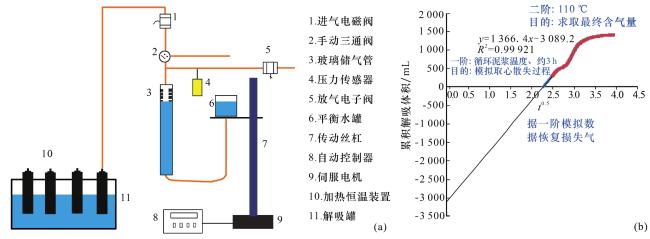
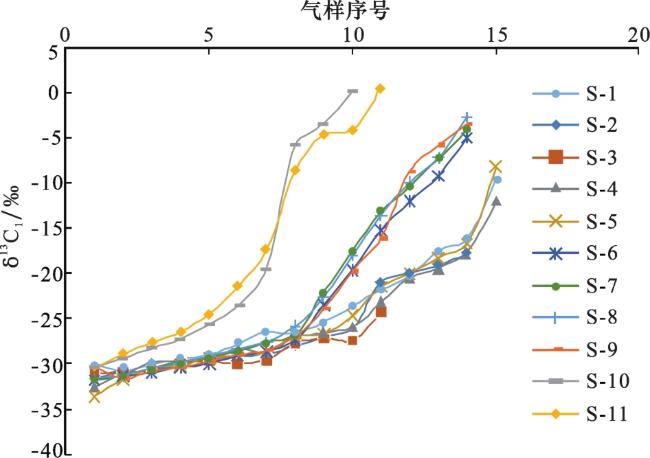
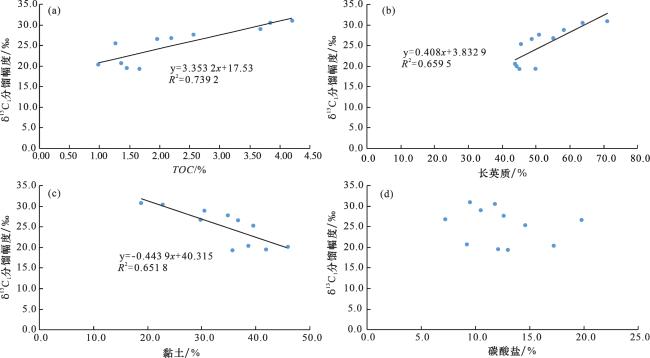

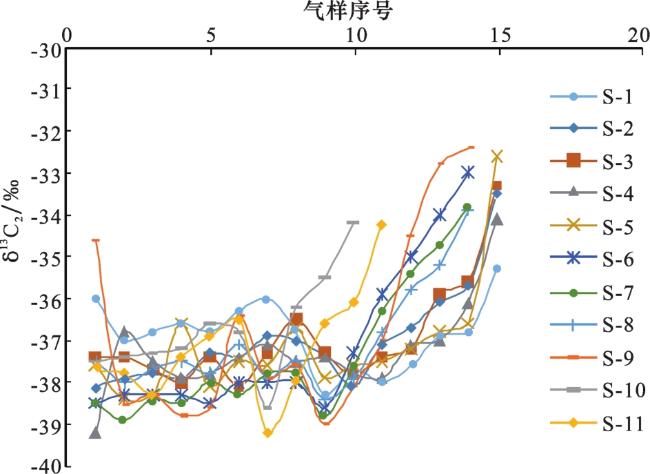
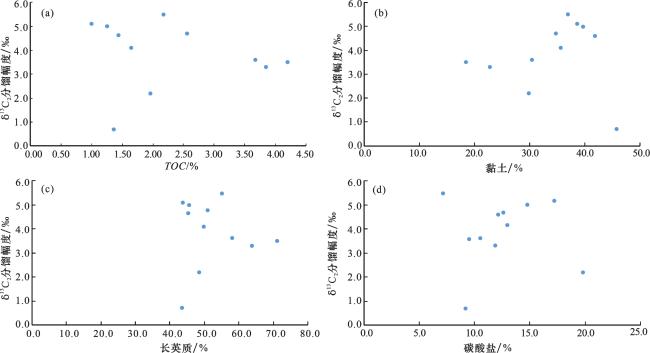

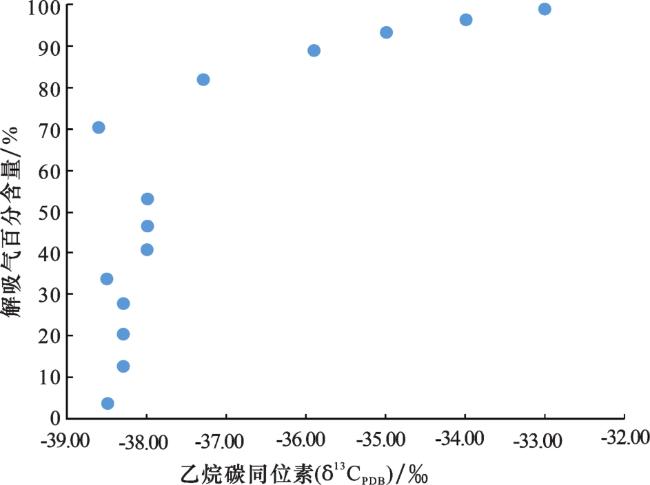
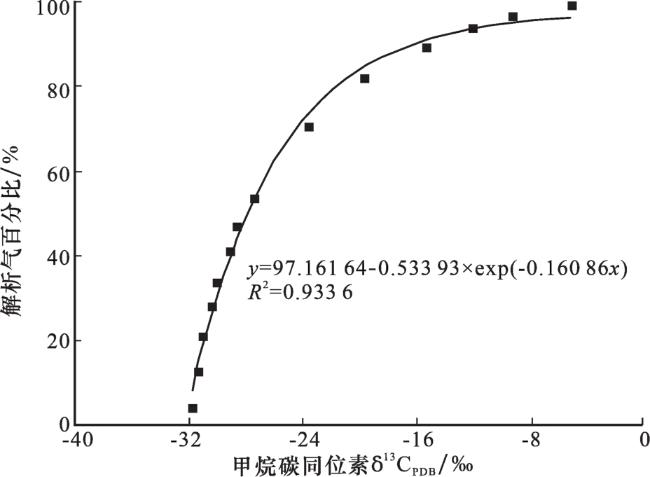
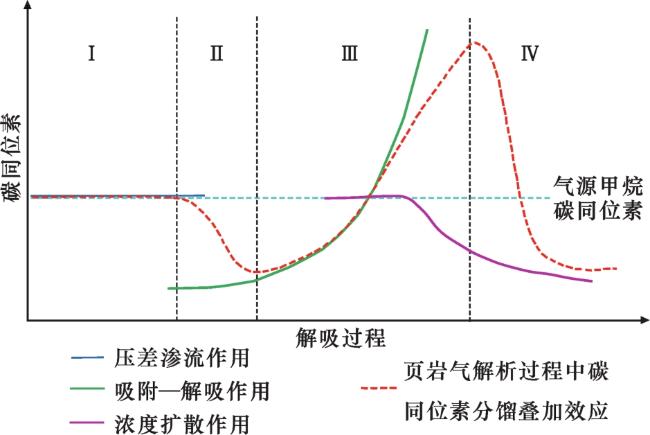
 甘公网安备 62010202000678号
甘公网安备 62010202000678号